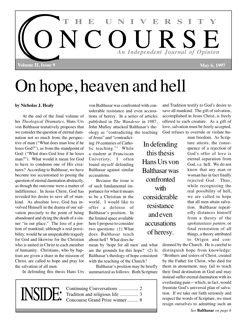Why tradition in the liturgy is so important to our religious life
by Alice von Hildebrand
I just wish to comment on Adam Tate’s excellent article: “Traditionalists, Charismatics and the Liturgy.” One Phrase struck me particularly. He relates that while in Gaming, he “discovered the richness of the Catholic tradition…” This is, I believe, the crucial issue. We live in a world that is “alienated,” cut off from its roots, from its past, from its “source.” My students have taught me to sympathize with the anguish of those who do not know where they belong, who do not know “their name.” It was Plato who wrote centuries ago: “...tradition, if no breath of opposition ever assails it, has a marvelous power.”
One thing is certain; the world in which we live has cut off its umbilical cord with its ancestors. The technological changes which have taken place in the course of the last sixty years are so mind-boggling that it is hard for a child to realize that its grandparents had no radios, and that the telephone was a rarity in most houses.
But in our context, the theme is the liturgy, and once again we face the same phenomenon: most contemporary liturgical services have radically deviated from tradition. An acquaintance of mine (who had not attended Mass for twenty-seven years, being a fallen away Catholic) came to my husband’s funeral Mass, and remarked to his wife: “I never realized that the changes were so radical: it is so totally different from what I knew as a college student.”
Alas, my faith is very weak. How often do I find myself in church, in a state of complete spiritual aridity. When I attend a Tridentine Mass, the thought that the Liturgy is the very same that was experienced by a St. Teresa of Avila, by a St. Francis de Sales, by a St. Vincent de Paul, by a holy Cure d’Ars, by a St. Dom Bosco, by a St. Therese of Lisieux, by a Mother Cabrini, gives me wings. Their faith, their love carry me; I join then my prayers to theirs, and offer to God their ardent love. I imagine that if they were to come back on earth to pay a brief visit to their suffering brothers, they would find the exterior world totally foreign to them, but if they were to enter a Catholic church where the Tridentine Mass is celebrated, they would find themselves “at home.” I cannot help but believe that if they attended a charismatic service, they would be quite baffled.
When I first came to the United States, everything seemed so strange to me; I felt so hope-lessly lost and uprooted. But upon entering St. Patrick’s Cathedral in New York, and hearing the words: “Introibo ad altare Dei…” I found myself “at home,” and I understood that my true home on earth was and will remain the Holy Catholic Church, and that I would be Home wherever she should utter these sacred words. The Mass was the very same, in every single detail, as the one I had heard in my home country since I was four years old. I had found my roots.
But this is not all. Modern man is not only “alienated;” he is also terribly restless. This restlessness expresses itself either in an unhealthy craving for constant activities, or in a constant longing for change. I know a young man who had lost his faith, left home quite young, and restlessly wandered from state to state until, exhausted and on the point of mental collapse, he found his way back into the Church. Since then, he has stayed in one place, serving God with faithful love.
The USA is a country of doers. We live in a sort of beehive of ceaseless activity. For most men, the alternatives in life are “work or fun.” No place is left for silence and contemplation: pillars of religious life. The traditional Mass is typically contemplative, totally centered on God, in an adoring posture. The words of consecration are only whispered—an adequate expression of the tremendous mystery that is taking place on the altar. Most people today—“hooked” on activity, feel lost when they do not do things: such as singing hymns, moving their arms, clapping, playing the guitar, distributing communion. It is easier to keep people in church for two full hours playing the guitar and singing hymns, than to keep them silent and contemplative for ten minutes. For activity is much easier than contemplation. Physical work can be very hard, but it is easy compared to intense intellectual work (Plato already saw this clearly); and the latter is “easy” compared to pure contemplation: this total emptying of oneself, this striving for an abysmal silence which permits one to hear God’s voice, for God speaks only to those who have created total silence in their souls. Great spiritual leaders are always suspicious of those who hear God’s voice without having first created total silence in their souls.
The Tridentine Mass is contemplative, and this is why, I believe, many modern people find it difficult to relate to it. Yet, if there is something which modern man desperately needs, it is silence and contemplation.
It is certainly no accident that Adam Tate discovered the beauty of tradition in a renovated Carthusian monastery. In the middle ages, Europe was dotted with these oases of silent worship. The USA has had no Carthusian monastery until fairly recently. In the early seventies, one of my husband’s godchildren (a Jew who had entered the Church) founded the first American Carthusian monastery in Arlington, Vermont. The pragmatism which is rampant in Anglo Saxon countries is a great obstacle to an understanding of the contemplative orders. Like Voltaire (a deadly enemy of the Church), it favors active orders, orders that “do” something, such as education or taking care of the sick. But to spend the day praying seems a waste of time to so many! And yet, in eternity, we shall see that it is the prayers and sacrifices of unknown monks and nuns which, through God’s grace, keep the world from collapsing in total moral chaos.
Well-known author, speaker, and retired Professor Emeritus, Dr. Alice Jourdain von Hildebrand, is the widow of the great Catholic philosopher, Dietrich von Hildebrand. She is also a trustee of Franciscan University.


